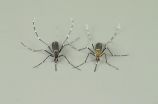(Press-News.org) One of the world's deadliest mosquitoes sustains its taste for human blood thanks in part to a genetic tweak that makes it more sensitive to human odor, according to new research.
Researchers report in the journal Nature that the yellow fever mosquito contains a version of an odor-detecting gene in its antennae that is highly attuned to sulcatone, a compound prevalent in human odor. The researchers found that the gene, AaegOr4, is more abundant and more sensitive in the human-preferring "domestic" form of the yellow fever mosquito than in its ancestral "forest" form that prefers the blood of non-human animals.
The research provides a rare glimpse at the genetic changes that cause behaviors to evolve, explained first author Carolyn "Lindy" McBride, an assistant professor in Princeton University's Department of Ecology and Evolutionary Biology and the Princeton Neuroscience Institute who conducted the work as a postdoctoral researcher at the Rockefeller University. Uncovering the genetic basis of changes in behavior can help us understand the neural pathways that carry out that behavior, McBride said.
The research also could help in developing better ways to stem the yellow fever mosquito's appetite for humans, McBride said. The yellow fever mosquito is found in tropical and subtropical areas worldwide and is the principal carrier of yellow fever, the measles-like dengue fever, and the painful infection known as chikungunya. Yellow fever annually kills tens of thousands of people worldwide, primarily in Africa, while dengue fever infects hundreds of millions. The research also suggests a possible genetic root for human preference in other mosquitoes, such as malaria mosquitoes, although that species is genetically very different from the yellow fever mosquito.
"The more we know about the genes and compounds that help mosquitoes target us, the better chance we have of manipulating their response to our odor" McBride said, adding that scent is not the only driver of mosquito behavior, but it is a predominant factor.
The researchers first conducted a three-part series of experiments to establish the domestic yellow fever mosquito's preference for human scent. Forest and domestic mosquitoes were put into a large cage and allowed to bite either a guinea pig or a researcher's arm. Then the mosquitoes were allowed to choose between streams of air that had passed over a guinea pig or human arm. Finally, to rule out general mosquito attractants such as exhaled carbon dioxide, mosquitoes were allowed to choose between the scent of nylon sleeves that had been in contact with a human or a guinea pig.
In all three cases, the domestic form of the yellow fever mosquito showed a strong preference for human scent, while the forest form primarily chose the guinea pig. Although domestic mosquitoes would sometimes go for the guinea pig, it happened very rarely, McBride said.
McBride and colleagues then decided to look for differences in the mosquitoes' antennae, which are equivalent to a human's nose. They interbred domestic and forest mosquitoes, then interbred their offspring to create a second hybrid generation. The genomes of these second-generation hybrids were so completely reshuffled that when the researchers compared the antennae of the human- and guinea pig-preferring individuals they expected to see only genetic differences linked directly to behavior, McBride said.
The researchers found 14 genes that differed between human- and guinea pig-preferring hybrids -- two of them were the odorant receptors Or4 and Or103. Choosing to follow up on Or4, the researchers implanted the gene into fruit-fly neurons. They found that the neurons exhibited a burst of activity when exposed to sulcatone, but no change when exposed to guinea pig odors. McBride plans to further study Or103 and other genes that could be linked to host preference at Princeton.
This work provides insight into how the domestic form of the yellow fever mosquito evolved from its animal-loving ancestor into a human-biting specialist, McBride said. "At least one of the things that happened is a retuning of the ways odors are detected by the antennae," she said. "We don't yet know whether there are also differences in how odor information is interpreted by the brain."
INFORMATION:
The paper, "Evolution of mosquito preference for humans linked to an odorant receptor," was published by Nature Nov. 13, 2014.
This work was supported in part by the National Institutes of Health (NIDCD grant no. DC012069; NIAID grant no. HHSN272200900039C; and NCATS CTSA award no. 5UL1TR000043); the Swedish Research Council and the Swedish University of Agricultural Science's Insect Chemical Ecology, Ethology and Evolution initiative; and the Howard Hughes Medical Institute.
Adding tiny amounts of vegetable puree to milk and then rice at the time of weaning makes children more likely to eat vegetables, new University of Leeds research shows.
Infants who consumed either milk (breast milk or formula) followed by rice mixed with vegetable puree ate nearly half as many vegetables again as infants who ate just milk followed by baby rice.
Professor Marion Hetherington, of the School of Psychology at the University of Leeds, led the study. She said: "We took inspiration from French mothers, as previous studies in this area have shown that they ...
(SACRAMENTO, Calif.) -- In its first clinical application in pediatric patients, an investigational medication developed and manufactured at UC Davis has been found to effectively treat children with life-threatening and difficult-to-control epileptic seizures without side effects, according to a research report by scientists at UC Davis and Northwestern University.
The investigational formulation of allopregnanolone was manufactured by UC Davis Health System's Good Manufacturing Practice Laboratory. Two children were treated with the allopregnanolone formulation, one ...
LA JOLLA, CA - November 12, 2014 - Driving to work becomes routine--but could you drive the entire way in reverse gear? Humans, like many animals, are accustomed to seeing objects pass behind us as we go forward. Moving backwards feels unnatural.
In a new study, scientists from The Scripps Research Institute (TSRI) reveal that moving forward actually trains the brain to perceive the world normally. The findings also show that the relationship between neurons in the eye and the brain is more complicated than previously thought--in fact, the order in which we see things ...
(MEMPHIS, Tenn. - November 12, 2014) An international collaboration has identified frequent mutations in two genes that often occur together in Ewing sarcoma (EWS) and that define a subtype of the cancer associated with reduced survival. The research, conducted by the St. Jude Children's Research Hospital-Washington University Pediatric Cancer Genome Project and the Institut Curie-Inserm through the International Cancer Genome Consortium, appears in the current issue of the scientific journal Cancer Discovery.
Mutations in the genes STAG2 and TP53 have previously been ...
Giant otters may have a vocal repertoire with 22 distinct vocalization types produced by adults and 11 neonate vocalization types, according to a study published November 12, 2014 in the open-access journal PLOS ONE by Christina Mumm and Mirjam Knörnschild from University of Ulm, Germany.
Giant otters, found in South America, are very social and frequently vocalizing animals. They live in groups that may vary, but generally include a reproductive pair and their offspring, born in different years. Individuals engage in shared group activities and hold different social ...
Using fewer than twenty genomes, researchers were unable to find rare protein-altering variants significantly associated with extreme longevity, according to a study published November 12, 2014 in the open-access journal PLOS ONE by Hinco Gierman from Stanford University and colleagues.
Supercentenarians are the world's oldest people, living beyond 110 years of age. Seventy-four are alive worldwide, with twenty-two living in the United States. The authors of this study performed whole-genome sequencing on 17 supercentenarians to explore the genetic basis underlying ...
An educational approach in kindergarten focused on the development of executive functions--the ability to avoid distractions, focus attention, hold relevant details in working memory, and regulate impulsive behavior--in children improved academic learning in and beyond kindergarten, helping to overcome deficits in school readiness associated with poverty, according to a study published November 12, 2014 in the open-access journal PLOS ONE by Clancy Blair and C. Cybele Raver from New York University.
Based on the results, the authors suggest that executive function ...
An educational approach focused on the development of children's executive functions - the ability to avoid distractions, focus attention, hold relevant information in working memory, and regulate impulsive behavior - improved academic learning in and beyond kindergarten, according to a new study by researchers at NYU's Steinhardt School of Culture, Education, and Human Development.
Because some effects were especially pronounced in high-poverty schools, the findings hold promise for closing the poverty-related achievement gap and suggest that an emphasis on executive ...
The normally bland face of Uranus has become increasingly stormy, with enormous cloud systems so bright that for the first time ever, amateur astronomers are able to see details in the planet's hazy blue-green atmosphere.
"The weather on Uranus is incredibly active," said Imke de Pater, professor and chair of astronomy at the University of California, Berkeley, and leader of the team that first noticed the activity when observing the planet with adaptive optics on the W. M. Keck II Telescope in Hawaii.
"This type of activity would have been expected in 2007, when Uranus's ...
In the fight against HIV, microbicides--chemical compounds that can be applied topically to the female genital tract to protect against sexually transmitted infections--have been touted as an effective alternative to condoms. However, while these compounds are successful at preventing transmission of the virus in a petri dish, clinical trials using microbicides have largely failed. A new study from the Gladstone Institutes and the University of Ulm now reveals that this discrepancy may be due to the primary mode of transportation of the virus during sexual transmission, ...



